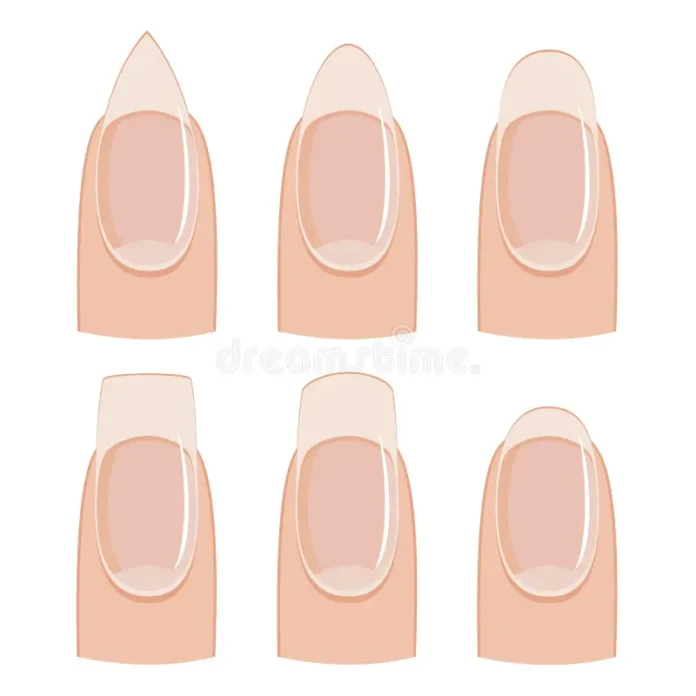Nail shape Celebrity nail artist Holly Falcone says the most common shapes include the classics: round, square, oval, and almond. After those, you’ll find some sort of variation that mixes two classic shapes into one, such as the squoval, or longer nails that lend themselves to intricate designs like the stiletto or ballerina.
What Are the Different Types of Nail Shapes?
- Square Nails. You can get square-shaped nails by having them flattened at the top with sharp corners and straight sides. …
- Squoval Nails. …
- Round Nails. …
- Almond Nails. …
- Stiletto Nails. …
- Ballerina Nails. …
- Flare Nails.
Why nail shape is important
Nail shape plays a significant role in both aesthetics and function. Here are some reasons why it is important:
Aesthetic Appeal
- Personal Style: Different it can reflect your personality and style. For example, almond-shaped nails may appear elegant, while square nails can look modern and chic.
- Finger Appearance: The right it can enhance the appearance of your fingers. Certain shapes can make fingers look longer and more slender, while others may make them look shorter or wider.
- Trend Alignment: Fashion trends often influence it. Keeping up with popular it can make your manicure look current and fashionable.
What material used to make nail shape?
it can be created using various materials depending on the desired outcome and application method. Here are some common materials used in nail shaping:
- Acrylic: A popular material for creating nail shapes, acrylic nails are made by mixing a liquid monomer and a powder polymer to form a hard, protective layer over the natural nail. Acrylic nails can be shaped into various forms, including square, round, almond, stiletto, and coffin.
- Gel: Gel nails use a gel-based formula that hardens under a UV or LED light. Gel can be used for extensions or overlays and is also highly versatile for shaping into different styles.
- Dip Powder: Dip powder nails involve a process where the nail is dipped into a colored powder and then sealed with a clear protective coating. This method provides a durable finish and can be shaped into various styles.
- PolyGel: A hybrid between acrylic and gel, PolyGel is a lightweight, easy-to-use material that can be molded and shaped easily before being cured under a UV or LED light.
- Silk Wraps: Silk wraps are thin pieces of silk fabric applied to the nail to add strength and support. They are often used to repair broken nails or to add a bit of length and shape to natural nails.
- Fiberglass: Similar to silk wraps, fiberglass nails use a piece of fiberglass fabric to add strength and shape to the nail. They are less commonly used but provide a durable finish.
- Natural Nail: The natural nail can also be shaped and styled using various nail files, buffers, and shaping tools. Manicurists can achieve different nail shapes by filing the natural nail into the desired form.
Each material offers different benefits and is chosen based on the desired nail shape, durability, and application process.
What are the cost of nail shape?
The cost of shaping your nails can vary depending on several factors such as location, type of salon, and whether you are getting additional services like a manicure or nail art. Here are some general price ranges:
- Basic Nail Shaping (without manicure):
- Basic shaping at a standard nail salon: $5 – $10
- Nail Shaping with a Basic Manicure:
- Basic manicure (including nail shaping) at a standard nail salon: $20 – $30
- Nail Shaping with Gel or Acrylic Nails:
- Gel or acrylic nails (including shaping) at a standard nail salon: $35 – $70
- High-End Salons or Specialty Services:
- High-end salons or specialty nail art services can range from $50 to over $100, depending on the complexity and design.
These prices can vary based on your location and the specific salon’s pricing structure. It’s a good idea to check with local salons for more accurate pricing.
Conclusion of nail shape
The conclusion of nail shape involves understanding the various types of nail shapes and their suitability based on personal preferences, nail health, and lifestyle needs. Choosing the right nail shape depends on balancing aesthetics with practicality, considering factors like nail strength, lifestyle activities, and personal style preferences.
